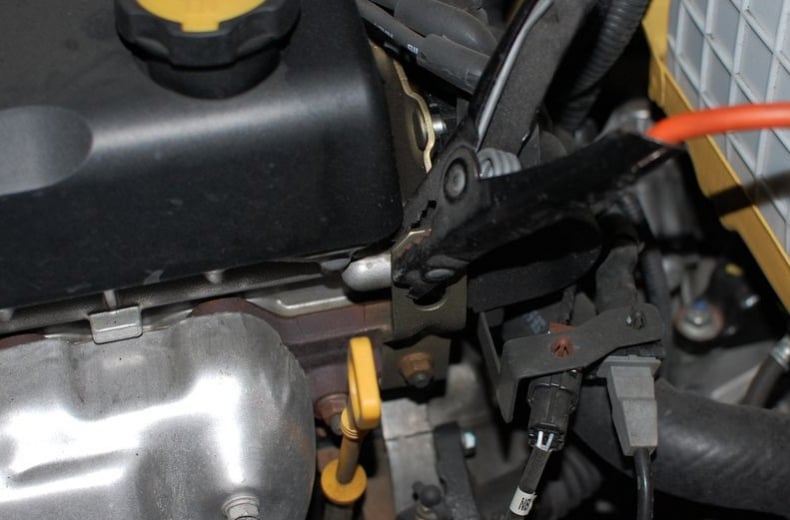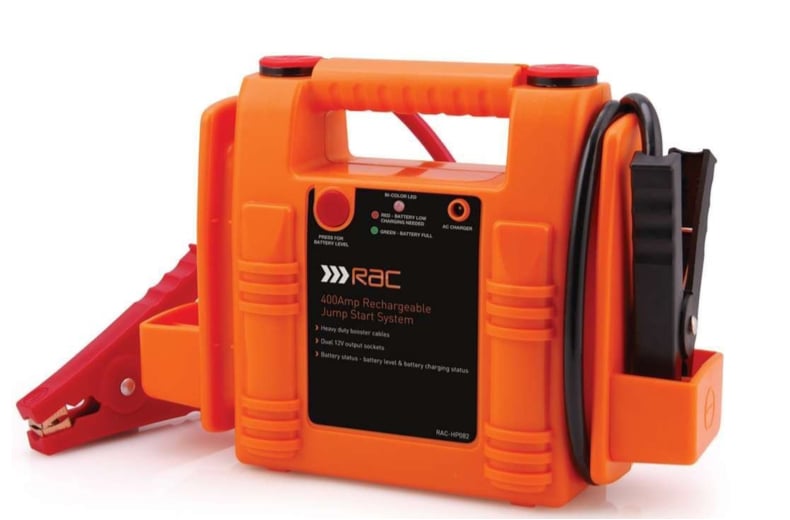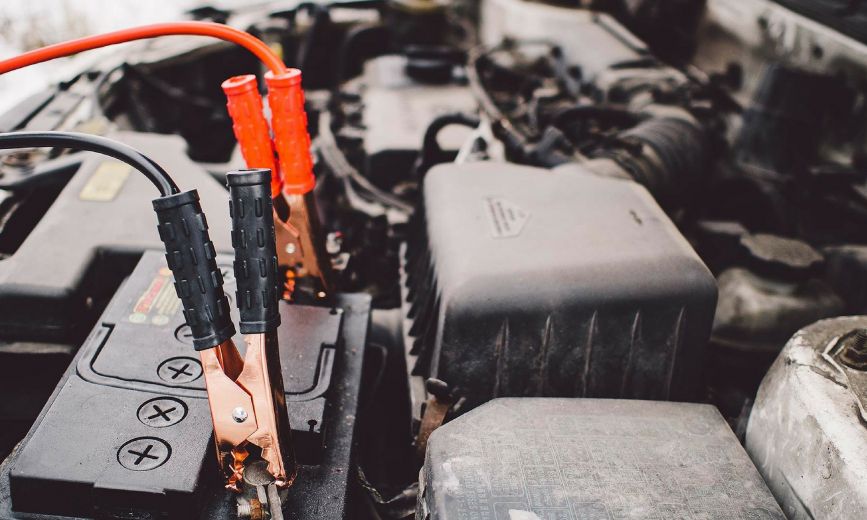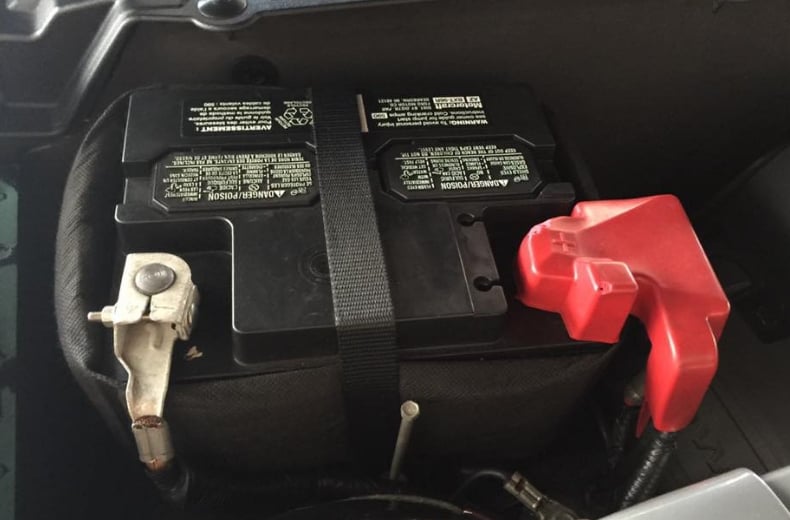Please note, jump starting a car can cause damage to the vehicle and the battery if not performed correctly - so contact a professional mechanic or get in touch with the RAC if you are unsure or have any questions about the process.
If you're not sure that the issue is definitely being caused by the battery, find out how to tell if you have a flat battery here.
How to jump start a car with jump leads
The most common and effective means of getting your car going with a flat battery is by using jump leads.
What do I need to jump start a car with jump leads?
- A second vehicle with a fully charged battery. Avoid using a hybrid or electric car as this could cause damage.
- A pair of quality jump leads. You can buy a set of jump leads from the RAC shop.
Safety precautions before jump starting a car with jump leads
When jump starting a vehicle, it’s important not to take risks.
Consult the owner's manual first and if you’re not confident that you know what you’re doing, contact RAC Breakdown and we’ll be happy to help.
- Check for damage - if there’s any obvious damage to either of the batteries, or the jump leads, don’t risk attempting a jump start
- Remove any rings or metal jewellery you’re wearing and make sure nothing metal touches the terminals on the battery.
Get a service or repair at home
RAC Mobile Mechanics can come to you, saving you the hassle of going to a garage.


Ten steps to jump start a car
- Before starting, make sure any electrical systems or devices in the vehicle with the dead battery are switched off (Lights, radio/CD, sat-nav etc) and if possible, lower the drivers window.
- Park the second vehicle as close to the casualty vehicle as possible, without the vehicles touching, ensuring the jump leads will comfortably reach from one battery to the other.
- Ensure both vehicles engines are switched off, remove the ignition keys and open their bonnets (or boot if the battery’s located there).
- Attach one end of the red jump lead to the positive terminal on the flat battery. The positive terminal will usually have a red plastic cover with a plus (+) symbol on it. Pull the cover back to access the terminal.
- Then attach the other end of the red jump lead to the positive terminal of the good battery on the second vehicle.
- Attach one end of the black jump lead to the negative terminal of the good battery.
- Then attach the other end of the black jump lead to a good earth point on the casualty vehicle – a solid metal part of the engine is usually best.
- Now attempt to start the casualty vehicle. If it doesn’t start after a few attempts, it might be more serious than a flat battery. In this event, seek professional help by contacting the RAC.
- If it does start, leave it running for about five minutes.
- Switch off the casualty vehicle, disconnect the negative jump lead then check the engine starts again okay. Disconnect the remaining jump leads.

Attach the other end of the black jump lead to a good earth point on the casualty vehicle – a solid metal part of the engine is usually best
How to safely remove the jump leads
- Switch off the engines on both vehicles
- Disconnect the black jump lead that is connected to the casualty vehicle
- Disconnect the other end of the black jump lead from the second vehicle
- Disconnect the red jump lead that is connected to the second vehicle
- Disconnect the other end of the red jump lead from the battery on the casualty vehicle
After the leads have been removed
Restart the engine on the casualty vehicle.
The battery will need to recharge fully for it to be fully serviceable, which is best achieved using a quality battery charger for several hours.
In the meantime, if possible, drive the vehicle normally (not in heavy traffic) for around 30 mins to try to put some charge back into the battery.
What concerns you most about a failing starter motor?
Bump starting a car
The RAC do not recommend bump starting vehicles.
Please follow the advice in the How to jump start a car with jump leads or How to jump start a car with a portable battery pack sections.
How to jump start a car with a portable battery pack

If you're worried about getting stranded with a flat battery when you are unable to call for help or seek assistance from someone, then you can buy a portable battery pack as a precaution, to keep you mobile if your battery goes flat.
These can be purchased from the RAC shop and are able to jump start a car without the use of another vehicle.
- 10 checks to prevent a winter breakdown
- What to do if you have a flat battery
- Car battery conditioners and trickle chargers – everything you need to know
- RAC starter motor repair and replacement
Before you start
When jump starting a vehicle, it’s important not to take risks. Consult your owners manual first and If you’re not confident that you know what you’re doing, contact the RAC and we’ll be happy to help.
- Check for damage - if there’s any obvious damage to either of the batteries, or the jump leads, don’t risk attempting a jump start
- Remove any rings or metal jewellery you’re wearing and make sure nothing metal touches the terminals on the battery.
Jump starting with a portable battery pack
First check that the battery pack is fully charged.
Locate the vehicle battery - usually situated in the engine bay under the bonnet, but in some vehicles, it is located in the boot. It’ll probably be hidden under a plastic cover – unclip this and you should see the battery with its two terminals.
Connect the positive (red) lead from the battery pack to the positive (+) terminal of the battery. Connect the negative (black) lead to a good earth point on the casualty vehicle – a solid metal part of the engine is usually best.
Stand the battery pack on the ground next to the vehicle, the leads are usually long enough to reach the battery. Avoid placing it on the engine as it might fall off when the engine starts.
Once the battery pack is connected, switch on the pack and attempt to start the vehicle as you normally would. If it doesn’t start after a few attempts, it might be more serious than a flat battery. In this event, seek professional help by contacting the RAC. If you need a repair, you can contact an RAC Approved Garage or RAC Mobile Mechanic.
If the vehicle does start, keep the engine running for about 5 minutes. Switch off the engine, then switch off the battery pack and remove the leads from the battery pack. Now restart the engine again.
The vehicles’ battery will need to recharge fully for it to be fully serviceable, which is best achieved using a quality battery charger for several hours. In the meantime, if possible, drive the vehicle normally (not heavy traffic) for around 30 mins to try to put some charge back into the battery.
If your MOT is due or if you would like to book your vehicle in for a full car service, you can book online with a RAC Mobile Mechanic or your local RAC Approved Garage today.
Hopefully you won't need this information anytime soon, but make sure you have breakdown cover, van breakdown cover or business breakdown cover sorted just in case!
When roadtripping abroad, European Breakdown Cover will have you covered too.
Get 30 driving tips that will save you money
Running a car isn’t cheap, but there are some easy things you can do to keep your costs down. Get these tips and more useful driving articles sent straight to your inbox now.


Jump starting a car FAQs
- Will my car start again after being jumped?
Once you’ve jump started your car, you should drive for at least 30 minutes (in normal driving conditions, not heavy traffic) before stopping to give your battery long enough to build up some charge.
If you don’t drive for long enough before stopping, it’s likely you’ll need another jump start after you’ve stopped, which could put undue stress on your vehicle.
- How do you jump start a car without another car?
If you’re concerned you’ll need to jump start your car when you don’t have access to another vehicle, you might want to invest in a portable battery pack that you can keep in your car.
This will ensure you can charge your battery on-the-move in case you get stranded. The RAC does not recommend push starting your car.
- Can I drive my car after a jump start?
Yes, although you should let your car’s battery charge up sufficiently before attempting to drive it, to avoid putting you or other road users at risk.
If jump starting from another vehicle, leave both vehicles running for at least 5 minutes before attempting to drive your car. If jump starting from a battery pack, leave your battery to charge for as long as possible before driving.
- Can a car battery be too dead to jump start?
It’s possible to jump start a battery even if it’s ‘dead’ by following the advice on this page. However, if your car doesn’t start, it could signal an underlying problem with your battery – meaning it needs replacing – or another electrical issue with your car.
- What do I do when my car battery dies?
If your car battery dies, you have two options to try and jump start it yourself.
Firstly, you can use jumper cables to jump start your car from another vehicle with a good-quality battery.
The second option is charging your battery using a portable charger. You should avoid push starting your car.
If you’re driving in Europe and your car battery dies, European breakdown cover will be able to help cover the cost of any repairs.
- Is it bad to push start a car?
The RAC does not recommend push starting or bump starting a vehicle, please follow the advice in the How to jump start a car with jump leads or How to jump start a car with a portable battery pack sections.
- Does jump starting a car drain your battery?
If you’ve been asked to help jump start a friend’s battery, you run the risk of frying one or both of the batteries if your battery is old or damaged in any way. Ensure your battery is in good condition before offering to help jump start anyone else’s car.
- How do you tell if it's your battery or alternator that’s faulty?
It can be difficult to know whether it’s your battery or alternator that’s at fault if you’re having issues with starting your engine, but there are some indicators you should watch for.
If your battery’s at fault, your battery warning light may be illuminated or your engine may need regular jumping. Tell-tale signs of your alternator being at fault are headlights and dashboard lights that are dimmer than usual, or your engine dying soon after a jump start.
- How do you jump start a completely dead car battery?
Even if you think your battery is completely ‘dead’, it’s still possible to jump start it by following the advice on this page.
However, if your car doesn’t start, it could signal an underlying problem with your battery – meaning it needs replacing completely – or another electrical issue with your car.
- Can you recharge a dead car battery?
It’s possible to jump start a battery even if it’s ‘dead’ by following the advice on this page.
However, if your car doesn’t start, it could signal an underlying problem with your battery – meaning it needs replacing completely – or another electrical issue with your car.
- What if a jump start doesn't work?
If your attempts to jump start your car don’t work, it could be the sign of your car having a more serious underlying issue with its battery and/or electrical system.
- Is jump starting a car dangerous?
Providing you follow the advice laid out on this page, it should be safe to jump start your car with either another vehicle’s battery or a portable battery pack.
However, before attempting to jump start a battery, ensure it’s not cracked or leaking as this could lead to an explosion and be sure not to smoke around either vehicle or lean over the battery of either car.
- Do I need to jump my car every time?
Car batteries go flat for a number of reasons, from something as simple as leaving your lights on to more serious faults with your car’s electronics.
However, if your battery needs jump starting every time you use it, it’s likely your vehicle has a more serious underlying problem with its electrical system or your battery needs replacing.
- Is it safe to jump start a car in the rain?
Jump starting your car in the rain is no more dangerous than doing so on a dry, sunny day although you may want to invest in an umbrella to stop you from getting soaked.
- What happens if you jump your car wrong?
Unfortunately, there are plenty of things that could go wrong with your car if you jump it incorrectly.
This includes damage to your battery, alternator and jumper leads which can lead to a costly replacement bill, so save yourself some money and follow the advice on this page correctly.
- Can you remove jumper cables while the car is on?
In order to keep yourself safe and avoid any damage to your vehicle, you should disconnect the black clamp from the car being jumped, then the other black end from the ‘good’ car, then the red clamp from the ‘good’ car, and finally the last red clamp from the jumped car.
- Can you jump start a hybrid?
Yes, for the 12V battery only. You should always check your owner’s manual for any special instructions, though.
- Can you jump start a car by using a hybrid as the donor vehicle?
No, do not attempt to jump start a vehicle with a flat battery by using a hybrid vehicle as the donor vehicle.
Services we offer
- Breakdown Cover
- European Breakdown Cover
- Motorbike Breakdown Cover
- Electric Car Breakdown Cover
- Caravan, Motorhome and Campervan Breakdown Cover
- Business Breakdown Cover
- Van Breakdown Cover
- RAC Approved Garages
- Vehicle servicing
- Vehicle repair
- MOTs
- Mobile mechanics
- RAC Tyres
- RAC Approved Dealers
- RAC Shop
- myRAC app
How to jump start a car FAQ
- Can using jump leads damage your car?
The most common danger when using jump leads is that, if done incorrectly, you can actually damage the car’s battery or other electrical components. If the jump leads are connected incorrectly, or if the clamps are placed on the wrong terminals, then it is possible for the battery to suffer damage.
In some cases, the battery or other electrical components can even be destroyed. This is why it is important to ensure that the jump leads are connected properly, and that the clamps are placed on the correct terminals.
If you’re not sure how to use jump leads correctly, it’s best to consult a professional mechanic rather than trying to do it yourself. This will ensure that you don’t accidentally cause any damage to your car. - What order do you connect jump leads?
When connecting jump leads, the order is very important and should be followed in order to ensure the safety of both vehicles and people. Here’s the step-by-step process:
1. Park both cars near each other, and make sure both cars are in neutral or park and the ignition is off for both cars.
2. Connect one red clamp of the first jump lead to the positive (+) terminal of the dead battery.
3. Connect the other red clamp of the same jump lead to the positive (+) terminal of the working battery.
4. Connect one black clamp of the first jump lead to the negative (-) terminal of the working battery.
5. Connect the other black clamp of the same jump lead to an unpainted metal surface of the car with the dead battery. Make sure it’s away from the battery and any moving parts.
6. Start the car with the working battery.
7. After a few minutes, try to start the car with the dead battery.
8. Once the car with the dead battery is running, remove the jump leads in reverse order. Start with the black clamp on the unpainted metal surface, then the black clamp on the working battery, followed by the red clamp on the working battery and finally the red clamp on the dead battery. - Where do jump leads go on a car?
The connection process is as follows:
1. Connect one of the red clips to the positive (+) terminal of the car with the dead battery.
2. Connect the other red clip to the positive (+) terminal of the car with the working battery.
3. Connect one of the black clips to the negative (-) terminal of the car with the working battery.
4. Connect the other black clip to an unpainted metal surface on the car with the dead battery. This is important to avoid sparks when the leads are connected.
When the process is complete, the car with the dead battery should start. Once it is running, you should disconnect the leads in the reverse order to avoid short-circuiting the car’s electrical system. - What is the proper procedure for jumping a car?
Jumping a car is a simple process, but it’s important to follow the proper procedure to ensure both your safety and the safety of other drivers.
1. Park both vehicles close to each other and turn off all electronics in both cars.
2. Connect one end of the jumper cables to the positive terminal of the dead battery and the other end to the positive terminal of the good battery.
3. Connect one end of the jumper cables to the negative terminal of the good battery and the other end to a metal ground on the car with the dead battery. Make sure the clamps stay away from any moving parts on the car.
4. Start the car with the good battery and wait a few minutes for the charge to transfer.
5. Start the car with the dead battery and let it run for a few minutes.
6. Disconnect the jumper cables in the reverse order, starting with the ground and then the negative terminal.
7. Take your car for a test drive to ensure that the battery is working correctly. - Can you take jump leads off with engine running?
The short answer is no, you cannot take jump leads off with the engine running. This is because jump leads transfer electricity from one car battery to another, and they must remain connected while the process is taking place. If you disconnect the jump leads while the engine is running, it could cause a spark, which could damage the electrical system or even cause a fire.
- Can you bump start modern cars?
Modern vehicles are typically equipped with an engine start/stop button, which eliminates the need to bump start the vehicle. Bumping a vehicle is when a manual transmission car is started by pushing or coasting downhill and popping the clutch. This starts the engine when the battery or starter motor fails.
However, it is still possible to bump start a modern car in the event that the battery or starter motor fails. To do this, you must have a manual transmission car and two people to help push the car. Push the car to a speed of about 10-15 mph. Then, press the clutch pedal in and turn the ignition key to the “on” position. If successful, the car should start.











